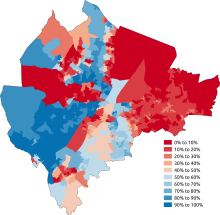
Back الفصل في أيرلندا الشمالية Arabic Segregación en Irlanda del Norte Spanish جداسازی در ایرلند شمالی Persian Ségrégation en Irlande du Nord French


| Part of a series on |
| Racial segregation |
|---|
 |
Segregation in Northern Ireland is a long-running issue in the political and social history of Northern Ireland. The segregation involves Northern Ireland's two main voting blocs—Irish nationalist/republicans (mainly Roman Catholic) and unionist/loyalist (mainly Protestant). It is often seen as both a cause and effect of the "Troubles".
A combination of political, religious and social differences plus the threat of intercommunal tensions and violence has led to widespread self-segregation of the two communities. Catholics and Protestants lead largely separate lives in a situation that some have dubbed "self-imposed apartheid".[1]
- ^ "Self-imposed Apartheid", by Mary O'Hara, published in The Guardian on Wednesday 14 April 2004. Accessed on Sunday, 22 July 2007.